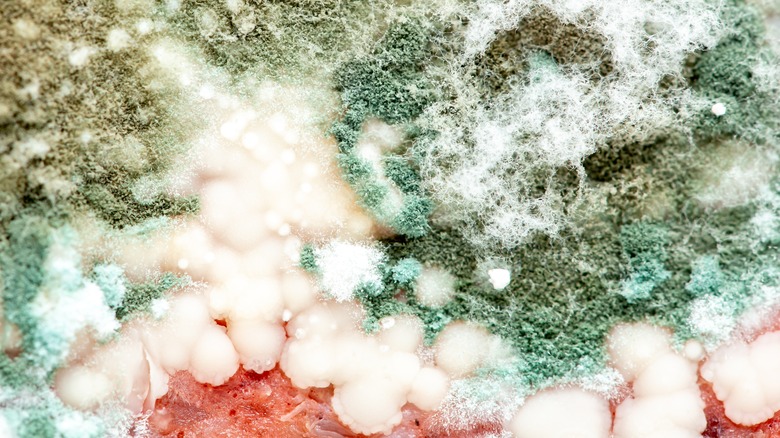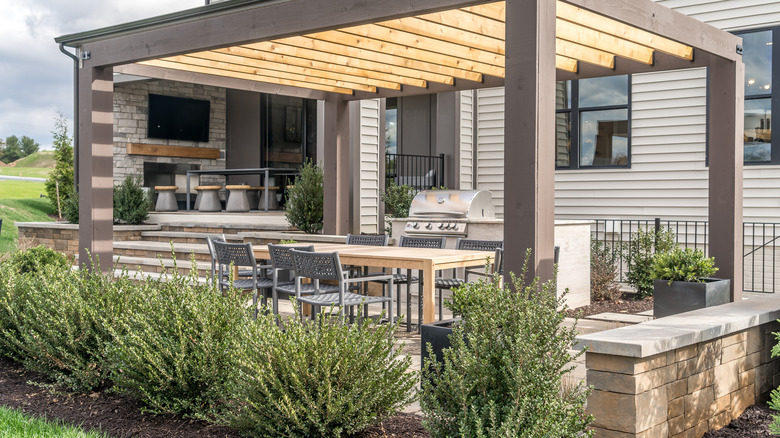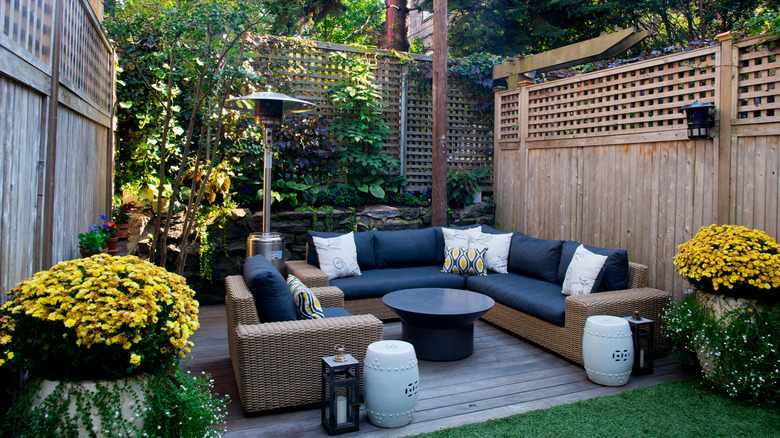The Best Way To Remove Mold And Mildew Off Of All Your Patio Furniture
There's a fungus among us that needs to be eliminated when mold and mildew invade your patio furniture. Dark, damp, and humid environments are a magnet for these household contaminants. Patio umbrellas, cushions, wicker furniture, and the space itself are vulnerable. According to JSE Labs, mildew can be thought of as an early-stage version of its more nefarious cousin, mold. The former thrives on flat surfaces, while the latter can infiltrate.
Mildew causes cosmetic damage while mold can have structural implications. Both can spread through spores, and mold, in particular, causes health problems and other damage if left unchecked. Mold can flourish on anything organic, even your favorite handbag. It manifests in a kaleidoscope of colors and may appear fuzzy or "hairy." Mildew tends to be downy or powdery, beginning as white or gray and gradually darkening. Both types of fungi produce a funky, musty smell.
Patio furniture can be a target of the unwelcome pair, with mildew being the likeliest culprit, explains Patioland USA. Natural fabrics are a mildew favorite. Fortunately, a DIY approach is up to the task of wiping out minor infestations. At least a half-dozen cleaning methods can successfully address the problem.
There are ways to anticipate and reduce the likelihood of contamination, and there are multiple preventative measures that are also effective. Allowing mold and mildew to get out of hand is an invitation to further damage and can be detrimental to one's health. A serious issue might require professional attention.
Home remedies
Patio Productions recommends using a solution consisting of hot water, dishwashing detergent, baking soda, and a touch of borax (sodium borate) to remove mold and mildew from some patio surfaces. Note: Even a small amount of borax is toxic to pets and children. Another note: When cleaning fungi or using caustic cleaners, observe safety precautions. Cleanipedia recommends wearing an N-95 mask. Donning goggles, gloves, and perhaps even an apron will further protect you.
A combination of ammonia, baking soda, distilled white vinegar, and water zaps mold and mildew, and it can be used in a spray bottle. Vinegar itself is an effective mold-killer. Problem areas can be treated with hydrogen peroxide for smell reduction. Diluted bleach in a ratio of 1/2-cup bleach and a gallon of water is a potent cleaner, keeping these tips in mind:
Never handle bleach if you are pregnant, and be sure not to mix it with ammonia. If using on cushions, make sure bleach is sufficiently diluted to avoid stripping the pigment, and per LoveToKnow, experiment with the mixture on a small, obscure area before applying it to the whole cushion. Using bleach on wood can be chancy, the same goes for canvas. However, Atlanta Teak Furniture asserts diluted bleach can safely be applied to teak as a last resort.
Alternatively, a lemon-salt mixture is a good non-chemical approach to combat mold and mildew.
Proactive prevention
Starting out with mold and mildew-resistant furniture is a sensible approach. Prudent Reviews suggests that printed acrylic, polyester, and vinyl are water-repellent options less likely to be infested than some fabrics. Furniture covers are a good defense, and a fabric seal spray can be used on them if they aren't already waterproof.
An ounce of prevention applies to ridding your patio furniture of mold and mildew. If your patio has a concrete surface, Plasticine House recommends swabbing it with a bleach/laundry detergent/water mix to prevent the M & M twins from roosting in its pores.
Patio furniture should routinely be kept clean and dry. Make sure to do so before stowing the pieces away for the winter and then again when taking them out of storage. When sitting in chairs or reclining in lounges, covering them with a towel will thwart moisture. Wet cushions should be wiped off immediately (always remember mold and mildew crave moisture). A dehumidifier also helps if the furniture is in an area that's enclosed.
When not in use, keeping umbrellas in the down position exposes furniture to more sunlight, keeping your patio inhospitable to mildew and mold intruders. Whatever you do to resist mold and mildew is warranted for both health and aesthetic reasons: The U.S. Environmental Protection Agency urges discarding anything that is too moldy and beyond salvaging.


